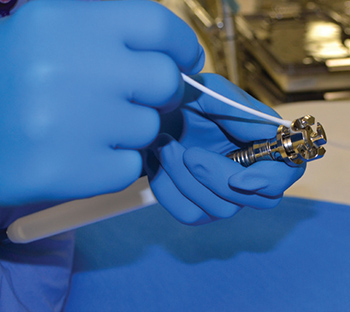Common inspection points for surgical instrumentation

Inspecting surgical devices is a time-consuming process. However, diligently checking every instrument prior to sterilization is essential to ensuring safe, proper functioning. As the last people to see devices before they are used for patient care, sterile processing technicians must be thorough. Exterior surfaces should be inspected for flaws such…
US News & World Report best ASCs ranking now available

Editor's Note With the goal of helping patients choose if outpatient care is right for them and identify the right ambulatory surgery center (ASC) for their needs, US News & World Report unveiled on May 14 its inaugural ranking of the best ASCs in the US. Reportedly, “fewer than 15%…
AAMI guidance covers sterile processing of dilators, ultrasound probes

Editor's Note A new guidance document covering the entire process for the selection, labeling, and sterile processing of dilators and ultrasound probes is available from The Association for the Advancement of Medical Instrumentation (AAMI). Released April 17, AAMI TIR99:2024; Processing Of Dilators, Transesophageal And Ultrasound Probes In Health Care Facilities…
One patient’s recovery highlights benefits of outpatient endoscopic spine surgery

Editor's Note A 64-year-old patient sought a second opinion with Kern Singh, MD, an orthopedic surgeon, when told he needed a second spine surgery to address complications from a previous procedure. Dr Singh, director of spine surgery at Midwest Orthopaedics at RUSH in Chicago, performs endoscopic spine surgery in the…
Study: GLP weight loss, diabetes therapies boost GI endoscopy pneumonia risk

Editor's Note Gastrointestinal endoscopy could increase the risk of aspirational pneumonia in patients using GLP-1 receptor agonists (RAs) to manage weight or treat diabetes, according to an April 1 report from MedPage today. Citing research published in the journal Gastroenterology by a team led by Kevin Sheng-Kai Ma, DDS, of…
Magnetic device controls nanorobots used in surgery

Editor's Note Scientists have found a new way to more precisely control tiny robots used in surgeries using an oscillating magnet. The findings were published in the journal npj Robotics (part of the Nature Portfolio) on March 28. Nanorobots capable of transporting drugs, performing surgical procedures, or taking tissue measurements…
Study: UV-C light effectively disinfects non-sterile, high-touch surfaces

Editor's Note Although many studies have focused on infection transmission within the operating room, authors of research published in the March issue of the Journal of Infection Control focused their study of UV-C light disinfection on non-sterile hubs of patient care—in this case, high-touch surfaces within an academic endoscopy unit.…
Forced-air device outperforms standard endoscope drying practices, study shows

Editor's Note Authors of a recent study evaluating the effectiveness of a forced-air drying system for endoscopes argue that the results reinforce the need to re-evaluate standard drying practices. Findings were published February 24 in the American Journal of Infection Control. Wet environments resulting from inadequate drying practices can result…
New gel protects tissue during gastrointestinal surgery

Editor's Note Researchers at MIT have developed a new gel called GastroShield to help prevent gastrointestinal bleeding during and after surgery performed during colonoscopy screenings. Advanced Materials published the findings on February 29. Colonoscopy screenings—undergone by some 20 million Americans each year—often result in doctors finding and removing polyps. These…
Study: Early postoperative endoscopy safe, effective for esophageal cancer patients

Editor's Note Using early postoperative endoscopy to detect anastomotic leakage after minimally invasive esophagectomy does not increase postoperative adverse events, according to a study published February 10 in the journal Surgery. Anastomotic leakage is one of the most severe adverse events of minimally invasive esophagectomy for esophageal cancer. Often deadly,…

 Free Daily News
Free Daily News